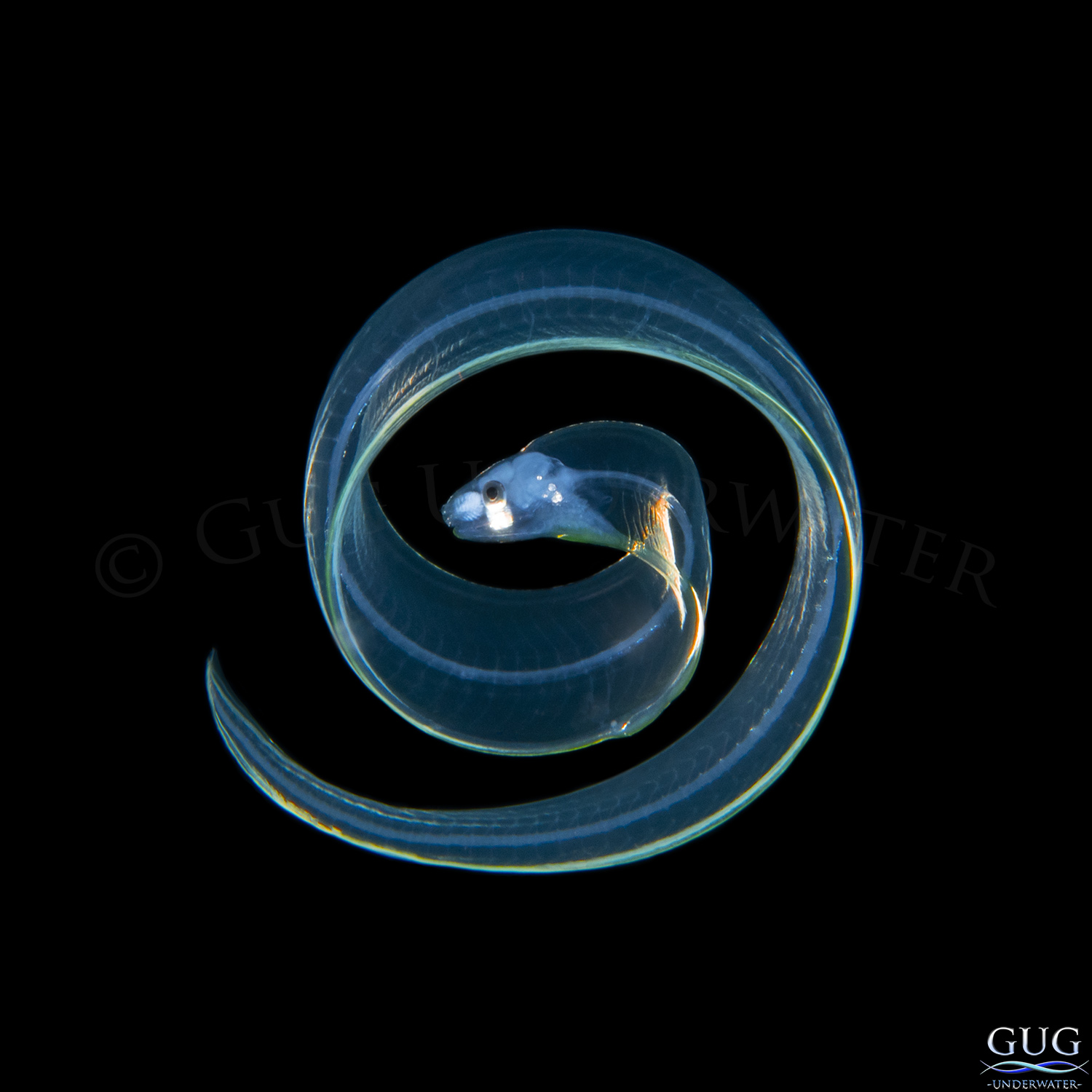Description
Alien #4 is a larval-stage conger eel, about 10-11cm long, so the diameter of it’s spiral here is ~2-2.5cm. Congers make up one of the major families of eel, but are a separate family from the morays and snake eels. But this photo is all about the spiral shape. It’s a behavior that is yet to be understood, but I’ve seen it several dozen times in both morays and congers. Larval eels in this clear stage are said to be in the leptocephalus stage. And they’re actually quite common while I’m hunting for Aliens out over the deep abyss at night. An average dive looking for Aliens is about 2 hours long, so when I say “common”, that means anywhere from 0-20 specimens on a dive. But normally, they’re hyperactively swimming in all directions, making them incredibly difficult to land the camera’s focus on their eyes and mouth, as they constantly wriggle, and are one of the fastest creatures in the plankton soup. But every so often, perhaps 20 times in my thousands of eel encounters, they’ll hover in this spiral pose, with a slow methodical bobbing, like they’re bouncing on a spring. Typically it lasts just a few seconds, and then they rapidly swim away again. Sometimes they repeat the coil, but often I’ll follow the eel for another 10 minutes to no avail. Science still has absolutely no idea of why they do it. A logical theory would be some kind of defense mechanism, as if it’s vulnerable head is safer at the inside of the coil, but I’ve seen no indication that stress from my presence, from my lights, from it making contact with me, or any other factor has made any difference. So the mystery remains, but it sure is beautiful when they do it!
One thing I love about photographing clear, translucent larval creatures, is how light refracts through their bodies like a rainbow. Often mistaken for bioluminescence, this is more akin to the experiment we did back in elementary school with splitting light using a prism. As my powerful strobes flash, the spectrum is split through their clear bodies, and we get a bit of a rainbow sheen. Being translucent is hugely advantageous for many creatures, as here in this leptocephalus stage, they never see the reef or the sea floor, so there’s nowhere to hide. Being clear helps them be a better tiny predator, and avoid the bigger fish who would happily make a meal out of them. In fact, most of the creatures in the Aliens plankton soup reproduce by playing the numbers game. Unlike us humans who make just a few behbehs and raise them well past adulthood (are they seriously still living in your basement?), many creatures in the sea produce a lot (hundreds/thousands) of offspring at a time, in hopes that three or four will not be eaten before making it to reproductive age. So a clear leptocephalus eel is far more likely to eat and not be eaten than an opaque one, when living in the middle of the water column and migrating upwards towards the surface every night, and back down into the abyss before each sunrise.
I love how you can see every rib coming off it’s spine. It’s developing olfactory organs are visible as feathery shapes at the snout, just ahead of it’s relatively large brain. It’s digestive tract hugs the bottom ridge just after it’s head, and terminates about 15% of the way down it’s body. And a common theme with many of the fish in the Aliens Collection, is the highly reflective back of the eye. Think about the eyeball anatomy of many common nocturnal creatures, such as cats, deer, etc. When your car headlights see a reflecting pair of eyeballs, it’s the same mechanism. For us diurnal humans, light enters the eye’s pupil, gets focused by the lens, and processed into an image. But in many creatures that we say have “night vision”, their eyes posses a tapetum lucidum – basically a reflective layer that allows more light to be reflected into the right focusing spot. That’s what we see in the opossum on the side of the road, and that’s what we see in this photograph, where it’s left eye looks normal, but through it’s clear head, there’s a harsh reflection caused by the back of the eel’s right eye – that’s it’s reflective tapetum lucidum!
For printing, we offer the Aliens as squares on either aluminum or canvas, but they are customizable into other shapes if your design plan requires it. You can purchase this luxury wall art online in standard sizes, but if you’d like to discuss a custom crop or size, please contact one of our design consultants at the art gallery. Perhaps our most popular arrangement for Aliens is a grouping of three of our 15″x15″ aluminums, but I encourage you to discuss the size & shape of your project’s wall, and one of our design consultants will help you develop an amazing contemporary art installation that blurs the lines between natural beauty and scientific fascination. Alien 21 is available up to a maximum size of 40″.


Reviews
There are no reviews yet.